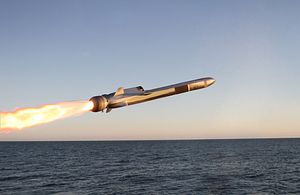The U.S. Marine Corps is adopting the Naval Strike Missile to provide it with a potent anti-ship capability to complement the U.S. Navy’s sea control mission. The U.S. Navy already employs the missile for its Littoral Combat Ships and for a future frigate design.
The Naval Strike Missile (NSM) was designed by Norway’s Kongsberg and is produced jointly with Raytheon, the world’s largest missile manufacturer. The missile has a 100 nautical mile range and is effective against both ships and land targets. Poland already fields a mobile, ground-based coastal defense version of the missile. According to Raytheon, because both the U.S. Navy and Marine Corps will now field the NSM, it will enhance joint interoperability and reduces costs and logistical burdens.
In February, the Commandant of the U.S. Marine Corps, General Robert Neller, told USNI News that he wanted to procure and field an anti-ship missiles “as soon as possible.” He explained that there was a ground component to maritime conflicts and that the Marines had to help the U.S. Navy control sea space from the land. “…there’s a lot of geographical chokepoints, and you know what they are, and the potential adversaries know what they are. So if you get there first and you can control that space, then you have an operational advantage.”
The NSM will be launched from a mobile platform, possibly from an adapted High Mobility Artillery Rocket System (HIMARS), a truck-mounted launching platform that the U.S. Marines already employ, or a similar system. The Marines use HIMARS to fire artillery rockets that have a 40 nautical mile range. The selection of the NSM gives the Marines an “off the shelf” system ready for immediate deployment as well as the flexibility to use it against both ships and land targets provides. The NSM and HIMARS rockets have similar sized warheads, but the NSM has more than twice the rocket’s range and greater precision.
The marines tested firing HIMARS from the deck of an amphibious ship against shore targets in 2017. The marines may similarly be able to fire Naval Strike Missiles from mobile launchers driven out on flight decks. This would provide amphibious groups with a potent defense against an adversary’s warships that currently has to be provided by escorting destroyers or cruisers.
The NSM could be incorporated into expeditionary concepts the Marines experimented with earlier this year in the “Pacific Blitz” exercise. In the exercise, marines practices raiding and seizing islands, and establishing temporary bases to support supply, rearming, and repairs for aircraft. A mobile battery of Naval Strike Missiles would both help defend those bases from being attacked by an adversary’s warships as well as providing a bubble of sea control that would make an adversary navy’s movement and freedom of action more difficult. By giving the marines their own capability to defend themselves against seaborne threats and project sea control on their own, it frees the U.S. Navy from having to commit ships to those missions and permits them to use them for other missions.
As I speculated earlier, the Naval Strike Missile was a strong candidate for the Marine Corps because its effectiveness as a ground-based missile was proven by the U.S. Army’s test at the 2018 Rim of the Pacific exercise, had already been purchased by the U.S. Navy, and unlike many other anti-ship missiles, has a land-attack mode that will provide the Marines with a new long-range strike capability against hardened ground targets.

































